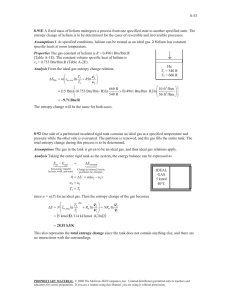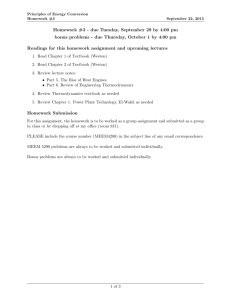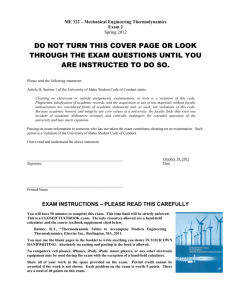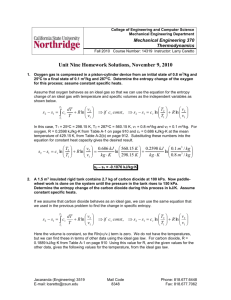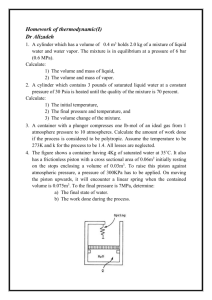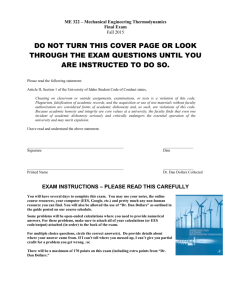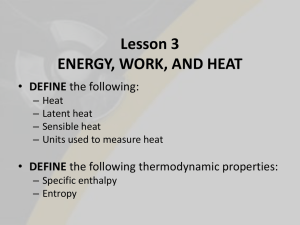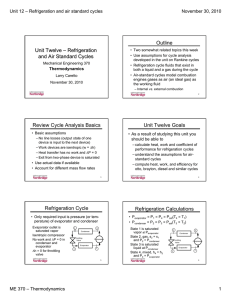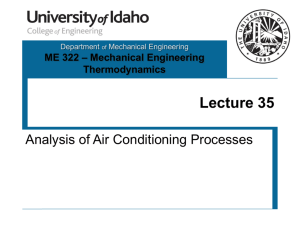mae 3309 THERMAL ENGINEERING Solutions to HW # 6 8
advertisement
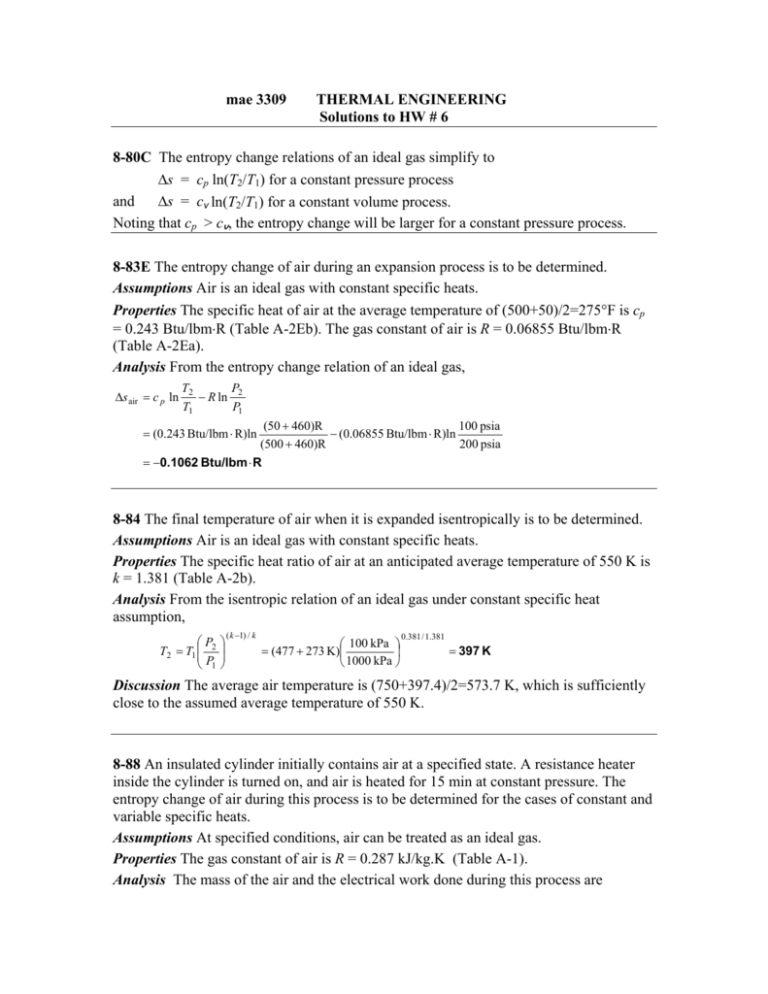
mae 3309 THERMAL ENGINEERING Solutions to HW # 6 8-80C The entropy change relations of an ideal gas simplify to Δs = cp ln(T2/T1) for a constant pressure process and Δs = cv ln(T2/T1) for a constant volume process. Noting that cp > cv, the entropy change will be larger for a constant pressure process. 8-83E The entropy change of air during an expansion process is to be determined. Assumptions Air is an ideal gas with constant specific heats. Properties The specific heat of air at the average temperature of (500+50)/2=275°F is cp = 0.243 Btu/lbm⋅R (Table A-2Eb). The gas constant of air is R = 0.06855 Btu/lbm⋅R (Table A-2Ea). Analysis From the entropy change relation of an ideal gas, Δs air = c p ln T2 P − R ln 2 T1 P1 (50 + 460)R 100 psia − (0.06855 Btu/lbm ⋅ R)ln (500 + 460)R 200 psia = −0.1062 Btu/lbm ⋅ R = (0.243 Btu/lbm ⋅ R)ln 8-84 The final temperature of air when it is expanded isentropically is to be determined. Assumptions Air is an ideal gas with constant specific heats. Properties The specific heat ratio of air at an anticipated average temperature of 550 K is k = 1.381 (Table A-2b). Analysis From the isentropic relation of an ideal gas under constant specific heat assumption, ⎛P T2 = T1 ⎜⎜ 2 ⎝ P1 ⎞ ⎟⎟ ⎠ ( k −1) / k ⎛ 100 kPa ⎞ = (477 + 273 K)⎜ ⎟ ⎝ 1000 kPa ⎠ 0.381 / 1.381 = 397 K Discussion The average air temperature is (750+397.4)/2=573.7 K, which is sufficiently close to the assumed average temperature of 550 K. 8-88 An insulated cylinder initially contains air at a specified state. A resistance heater inside the cylinder is turned on, and air is heated for 15 min at constant pressure. The entropy change of air during this process is to be determined for the cases of constant and variable specific heats. Assumptions At specified conditions, air can be treated as an ideal gas. Properties The gas constant of air is R = 0.287 kJ/kg.K (Table A-1). Analysis The mass of the air and the electrical work done during this process are ( ) (120 kPa ) 0.3 m3 P1V1 = = 0.4325 kg RT1 0.287 kPa ⋅ m3/kg ⋅ K (290 K ) We,in = W&e,in Δt = (0.2 kJ/s )(15 × 60 s ) = 180 kJ m= ( ) The energy balance for this stationary closed system can be expressed as E − Eout 1in 424 3 = Net energy transfer by heat, work, and mass ΔEsystem 1 424 3 Change in internal, kinetic, potential, etc. energies We,in − Wb,out = ΔU ⎯ ⎯→We,in = m(h2 − h1 ) ≅ c p (T2 − T1 ) W AIR 0.3 m3 120 kPa 17°C since ΔU + Wb = ΔH during a constant pressure quasi-equilibrium process. (a) Using a constant cp value at the anticipated average temperature of 450 K, the final temperature becomes Thus, T2 = T1 + We,in mc p = 290 K + 180 kJ (0.4325 kg )(1.02 kJ/kg ⋅ K ) = 698 K Then the entropy change becomes ⎛ T P ©0 ⎞ T ΔSsys = m(s2 − s1 ) = m⎜ c p ,avg ln 2 − R ln 2 ⎟ = mc p ,avg ln 2 ⎜ ⎟ T1 P1 ⎠ T1 ⎝ ⎛ 698 K ⎞ ⎟⎟ = 0.387 kJ/K = (0.4325 kg )(1.020 kJ/kg ⋅ K ) ln⎜⎜ ⎝ 290 K ⎠ (b) Assuming variable specific heats, We,in = m(h2 − h1 ) ⎯ ⎯→ h2 = h1 + We,in m = 290.16 kJ/kg + 180 kJ = 706.34 kJ/kg 0.4325 kg From the air table (Table A-21, we read s2o = 2.5628 kJ/kg·K corresponding to this h2 value. Then, ( ) ⎛ P ©0 ⎞ ΔSsys = m⎜ s2o − s1o + R ln 2 ⎟ = m s2o − s1o = (0.4325 kg )(2.5628 − 1.66802)kJ/kg ⋅ K = 0.387 kJ/K ⎜ P1 ⎟⎠ ⎝ 8-89 A cylinder contains N2 gas at a specified pressure and temperature. The gas is compressed polytropically until the volume is reduced by half. The entropy change of nitrogen during this process is to be determined. Assumptions 1 At specified conditions, N2 can be treated as an ideal gas. 2 Nitrogen has constant specific heats at room temperature. Properties The gas constant of nitrogen is R = 0.297 kJ/kg.K (Table A-1). The constant volume specific heat of nitrogen at room temperature is cv = 0.743 kJ/kg.K (Table A-2). Analysis From the polytropic relation, T2 ⎛ v1 ⎞ =⎜ ⎟ T1 ⎜⎝ v 2 ⎟⎠ n −1 ⎛v ⎞ ⎯ ⎯→ T2 = T1⎜⎜ 1 ⎟⎟ ⎝v2 ⎠ n −1 = (300 K )(2 )1.3−1 = 369.3 K Then the entropy change of nitrogen becomes N2 PV 1.3 = ⎛ V ⎞ T ΔS N 2 = m⎜⎜ cv ,avg ln 2 + R ln 2 ⎟⎟ T1 V1 ⎠ ⎝ ⎛ ⎞ 369.3 K = (1.2 kg )⎜⎜ (0.743 kJ/kg ⋅ K ) ln + (0.297 kJ/kg ⋅ K ) ln (0.5)⎟⎟ = −0.0617 kJ/K 300 K ⎝ ⎠ 8-91E A fixed mass of helium undergoes a process from one specified state to another specified state. The entropy change of helium is to be determined for the cases of reversible and irreversible processes. Assumptions 1 At specified conditions, helium can be treated as an ideal gas. 2 Helium has constant specific heats at room temperature. Properties The gas constant of helium is R = 0.4961 Btu/lbm.R (Table A-1E). The constant volume specific heat of helium is cv = 0.753 Btu/lbm.R (Table AHe 2E). T1 = 540 Analysis From the ideal-gas entropy change relation, R ⎛ T v ⎞ ΔS He = m⎜⎜ cv ,ave ln 2 + R ln 2 ⎟⎟ T v1 ⎠ 1 ⎝ ⎛ ⎛ 10 ft 3/lbm ⎞ ⎞ 660 R ⎟⎟ = (15 lbm)⎜ (0.753 Btu/lbm ⋅ R) ln + (0.4961 Btu/lbm ⋅ R ) ln⎜ ⎜ 50 ft 3/lbm ⎟ ⎟ ⎜ 540 R ⎠⎠ ⎝ ⎝ = −9.71 Btu/R The entropy change will be the same for both cases. ----------------------------------------------------------------------------------------------------
